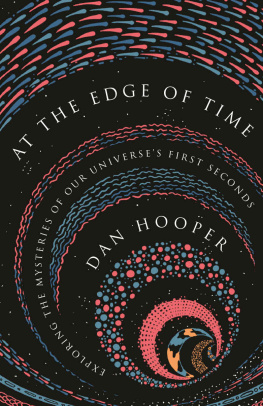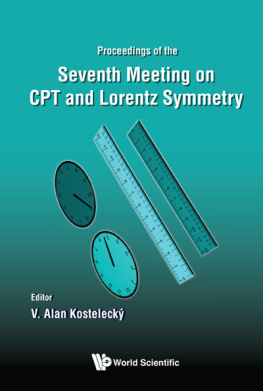
Also by Marcelo Gleiser
The Dancing Universe:
From Creation Myths to the Big Bang
The Prophet and the Astronomer:
Apocalyptic Science and the End of the World
A TEAR AT THE EDGE OF CREATION
A RADICAL NEW VISION FOR LIFE IN AN IMPERFECT UNIVERSE
Marcelo Gleiser


FREE PRESS
A Division of simon & schuster, Inc.
1230 Avenue of the Americas
New York, NY 10020
www.simonandschuster
Copyright 2010 by Marcelo Gleiser
All rights reserved, including the right to reproduce this book or portions thereof in any form whatsoever. For information address Free Press subsidiary rights Department, 1230 Avenue of the Americas, New York, NY 10020
Keplers Mysterium Cosmographicum printed from the original with permission from Herzog August Bibliothek Wolfenbuettel: 40 Astron.
First Free Press hardcover edition April 2010
FREE PRESS and colophon are trademarks of Simon & Schuster, Inc.
For information about special discounts for bulk purchases, please contact Simon & Schuster Special Sales at 1-866-506-1949 or business@simonandschuster.com
The simon & schuster Speakers Bureau can bring authors to your live event. For more information or to book an event contact the Simon & Schuster Speakers Bureau at 1-866-248-3049 or visit our website at www.simonspeakers.com .
DESIGNED BY ERICH HOBBING
Manufactured in the United states of America
10 9 8 7 6 5 4 3 2 1
Library of Congress Cataloging-in-Publication Data
Gleiser, Marcelo.
A tear at the edge of creation: a radical new vision for life in an imperfect universe / Marcelo Gleiser.1st Free Press hardcover ed.
p. cm.
Includes bibliographical references and index.
1. Cosmology. 2. Life (Biology) I. Title.
QB981.G575 2010
523.1dc22
2009046247
ISBN 978-1-4391-0832-1
ISBN 978-1-4391-2786-5 (ebook)
In memoriam
Carl Sagan (193496)
Your absence is most evident
The Universe is asymmetric and I am persuaded that life, as it is known to us, is a direct result of the asymmetry of the Universe or of its indirect consequences.
Louis Pasteur
It [is] hopelessly narrow-minded to imagine that all significant laws of physics had been discovered at the moment our generation began contemplating the problem. There would be a twenty-first-century physics and a twenty-second-century physics, and even a Fourth-Millennium physics.
Carl Sagan, Contact
Pure thought didnt supersede creative engagement with phenomena as a way of understanding the world twenty years ago, hasnt in the meantime, and wont anytime soon.
Frank Wilczek, Summary talk at
Expectations of a Final Theory,
Cambridge University, September 2005
I dont want to discourage string theorists, but maybe the world is what weve always known: the Standard Model and general relativity.
Steven Weinberg, CERN Courier, September 2009
CONTENTS
INTRODUCTION
If we dont have a distinctive position or velocity or acceleration, or a separate origin from the other plants and animals, then at least, maybe, we are the smartest beings in the entire universe. And that is our uniqueness.
Carl Sagan (1985)
All philosophy is based on two things only: curiosity and poor eyesight The trouble is we want to know more than we can see.
Bernard le Bovier de Fontenelle (1686)
Sometimes high walls must be torn down to reveal new vistas. For millennia, shamans and philosophers, believers and nonbelievers, artists and scientists, have tried to make sense of existence, searching for ultimate explanations of reality. Central to this quest for meaning is the notion of Oneness, which suggests that all that exists is somehow interconnected. Many religions call for a deity that transcends the constraints of space and time, a being of absolute power who designed the world and who controls, to a greater or lesser extent, the fate of humanity. Every day, billions of people go to temples, churches, mosques, and synagogues to pray to their divine incarnation of Oneness. Not too far from the houses of worship, scientists at universities and laboratories try to put together explanations of the natural world based on a surprisingly similar notion: under the apparent complexity of Nature, there is a simpler underlying reality where everything is somehow interconnected. In this book, I will argue that belief in a physical theory that unifies the secrets of the material worlda hidden code of Natureis the scientific equivalent to the religious belief in Oneness. We could call it monotheistic science. Some of the greatest scientists of all time, Kepler, Newton, Faraday, Einstein, Heisenberg, and Schrdinger, believed and searched for this elusive code. Nowadays, theoretical physicists, especially those trying to understand questions related to the composition of matter and the origin of the universe, call this code the Theory of Everything or the Final Theory. Is such a quest justified? Or is it fundamentally misguided?
Fifteen years ago, I would never have guessed that one day I would be writing this book. A true believer in unification, I spent my Ph.D. years, and many more, searching for a theory of Nature that reflected the belief that all is one. The most popular candidate for such a theory was (and still is) called superstring theory. This is a proposal whereby the fundamental entities of matter are not point particles like electrons, but wiggling strings of submicroscopic size that live in nine spatial dimensions. The mathematical elegance of the theory is compelling, as is its promise to fulfill the age-old dream of unification. Many of the brightest minds in theoretical physics are working to advance this theory and some of its rival proposals.
The cornerstone of any unification theory is the notion that a more profound description of Nature possesses a higher level of mathematical symmetry. Echoing the teachings of Pythagoras and Plato, this idea carries with it an implicit aesthetic judgment that such theories are more beautiful, and, as the poet John Keats wrote in 1819, that beauty is truth. And yet, as we investigate the experimental evidence for unification, or even for how such ideas can be experimentally verified, we find very little hard data supporting them. Of course, symmetry remains an essential tool in the physical sciences. But during the past fifty years, discoveries in experimental physics have shown time and again that our expectations of higher symmetry are more expectations than realities.
Although at first very distressing at a personal level, this realization eventually led my work in a new direction. I began to recognize that it is not symmetry but the presence of asymmetry that best represents some of the most basic aspects of Nature. Symmetry may have its appeal, but it is inherently stale: some kind of imbalance is behind every transformation. As I explain in this book, from the origin of matter to the origin of life, the emergence of structure depends fundamentally on the existence of asymmetries.
Slowly, my thoughts converged into an aesthetic based on imperfection rather than perfection. I found that asymmetry is beautiful precisely for being imperfect just as Marilyn Monroes mole is beautiful. The revolution in modern art and music started more than a century ago is, to a large extent, an expression of this aesthetic. Now, its time for science to let go of the old aesthetic that espouses perfection as beauty and beauty as truth.
Next page











